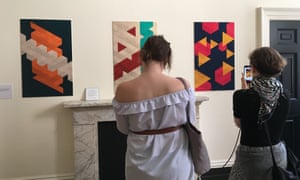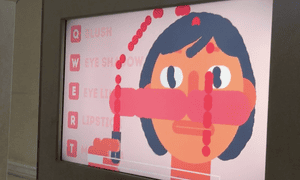
Morning Makeup Madness, one of the games on display at Now Play This. Photograph: Jordan Erica Webber for the Guardian
Now Play This is a festival of experimental games. Spread throughout several rooms of the New Wing of Somerset House, and running as part of the London games festival, it reflects what happens when we stop worrying about the artistic or commercial validity of the medium. Curated by game designers Holly Gramazio and George Buckenham, it’s about collecting experiences that offer something interesting, meaningful or special.
This year’s event featured games in a variety of formats: tabletop, physical, digital, augmented reality, virtual reality and new sports. There were experimental interfaces and there were fascinating intersections between space and content. One game, Joy is Here, covered all the walls in a giant word search.
Here are 13 of the most interesting things we saw:
Dead Pixels (Tatiana Vilela dos Santos and Olivier Drouet)

One of the best things about an event like Now Play This is that you get to experience games that are meant to be played by large groups – like the two- to nine-player Dead Pixels. Each participant stands at a plinth and uses a joystick to move a coloured square around a canvas, leaving a trail behind it. A closed shape of one colour automatically fills, while drawing over another colour produces a dead (black) pixel. The game ends after 99 seconds or when the canvas is full, and the colour with the largest area covered wins. While we were playing, one girl led her entire family team to successive victories, crowing with delight each time.
Poem Game (Liliane Lijn)
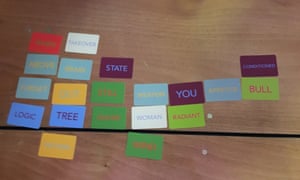
On Friday evening, a group of people gathered to play artist Liliane Lijn’s 1974 Poem Game. Each player (most of whom weren’t born when it was created) was handed a few coloured cards with one word on each side and took turns to either place one on the table or move/flip one already placed, and then read the current words in whichever direction they liked. As the words spread in all directions, a loose collective narrative began to build, until Lijn instructed the players to flip all the cards and read the result, fulfilling the stated intention of the game to “free the players from preconceived ideas of what a poem might be”.
Invisible Garden (Rosa Carbo-Mascarell and Tim Phillips)

Several attendees enjoyed the uncommonly warm weather by trying this game which used the exterior of Somerset House to calming effect. Players donned a handmade hat that hid a pair of headphones and a phone, and through geolocation, could wander the sunny courtyard hearing the changing sounds of a walk through a meadow – birds, frogs, and a babbling brook – rather than the London traffic.
Restless Spirit Projector (Viviane Schwarz and Jonatan Van Hove with Amber Hsu)
One of the most popular rooms was introduced with a plaque that read simply, “This room is haunted.” Engulfed in darkness, players used hand mirrors to reflect ghosts (projected sprites) into a trap (a light-detecting orb), pairing them up according to physical clues left around the room – and occasionally removed by the designer Viviane Schwarz – like a notebook filled with handwritten and illustrated stories about the ghosts in question.
Vaccination (Alex Johansson and Katy Marshall)

Vaccination was also part of the Leftfield Collection at Rezzed, but here was just one of many games with unique interfaces, if a particularly fun and impressive one. One player watches a monitor that shows microorganisms of various colours creep from a patient’s extremities to their heart. The other plugs a physical injector-shaped device into holes on a board to gather medicine and inject it into the head, limbs, or torso. Like a medicalised version of the popular Horde mode in shooter games, the patient always dies eventually.
Thread Racer (Miyu Hayashi and Richard Burns)
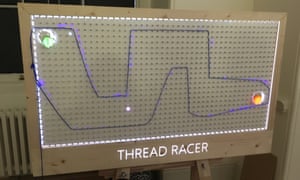
The play space for Thread Racer was a vertical board with a grid of pins, which players wrapped thread around to create a race track, and then used joysticks to navigate two dots of light around the track, jumping back to the start if they bumped into the thread. While it fell prey to predictable wear and tear that meant it didn’t function entirely as intended, this was a fun little experience that demonstrated creativity on the part of both designers and players.
Telephone (Lee Shang Lun)
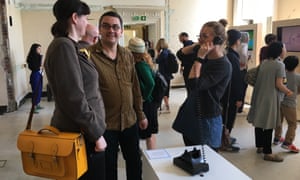
Lee Shang Lun is perhaps best known for his work on puzzle games Sokobond and Stickets, but Telephone is an entirely different experience. Commissioned for this event as part of the 10 Second Room, its physical presence is nothing more than an old-fashioned telephone on a plinth. Players who picked up the phone would hear a prompt – “What’s the grossest thing you would do for £10?” “What are five names you wouldn’t give your children?” – and their spoken replies were recorded, rearranged, and sent to another phone in a bar in Melbourne for people on the other side of the world to hear.
Morning Makeup Madness (Jenny Jiao Hsia)
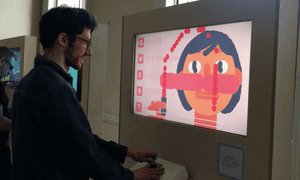
Another 10-second game is Jenny Jiao Hsia’s Morning Makeup Madness, in which you have 10 seconds to apply lipstick, blush, mascara, eyeliner, and eyeshadow to roughly the right places on a cute representation of a reflected face. At the end you’re given a percentage score, perhaps 10% “no makeup look” or 60% “hot mess”. It was hard to do particularly well with the joysticks at the event, but you can play it in your browser with a mouse and keyboard.
Sandcastles (Patrick Smith, Vectorpark)
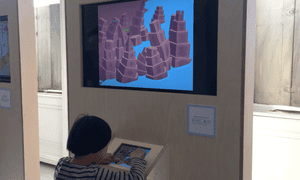
One 10-second game that took a more poignant look at the passing of time was Sandcastles. Players dragged fingers along a touch screen to pull castles of various shapes and sizes from the sand, but every 10 seconds the sea would come and wash the castles away.
Pink Trombone
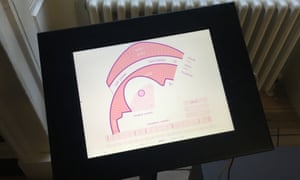
Perhaps of particular fascination to singers, Pink Trombone is an interactive simulation of human vocalisation. Presented with a side-on representation of a human nose, mouth and throat, players can move the various parts to make different vocal sounds. Besides actually being pretty informative, it is a cute and fun interactive toy that you can play with in your browser now.
